Graph is the
collection of distinct vertices
is the
collection of distinct vertices and distinct
edge
and distinct
edge .
.
A graph is said to be connected if every pair of vertices have the path between each of them.
• The new vertex s is added in the graph G to find
the minimum path between .
.
• The vertex of graph represents the individual object.
• A vertex v said to be adjacent to another vertex
S if the graph contain an edge
Therefore, the purpose of adding the new vertex s to V that yields V’ is to find the all pairs shortest path.
Consider a graph V. A new vertex s is added to graph V. After adding the vertex, the new set of edges is V’.
• In the graph, the vertices are represented with label
 and
edge is represented by line between the vertices.
and
edge is represented by line between the vertices.
• A path in a graph represents a way from source to destination by traversing the edge.
The new vertex s is addition helps to find the all pairs shortest path of the graph .
Weight with Non-Negative Edge
In order to understand relationship between w
and ,
it is necessary to understand Johnson’s algorithm. Johnson
algorithm uses concept of Dijkstra’s and Bellman-Ford algorithm for
finding the shortest path for all set of vertices. This algorithm
works on the methods of reweighting, if the graph has negative
weight cycle.
,
it is necessary to understand Johnson’s algorithm. Johnson
algorithm uses concept of Dijkstra’s and Bellman-Ford algorithm for
finding the shortest path for all set of vertices. This algorithm
works on the methods of reweighting, if the graph has negative
weight cycle.
Methods of reweighting are as follows:
1. Dijkstra’s algorithm is used for finding the shortest path, if weight of all the edges in the graph is non-negative. For each vertex Fibonacci heap priority queue is used for finding the shortest path.
2. Bellman-Ford algorithm is used for finding the shortest path, if weight of any edge in the graph is negative. Calculate new non negative edges from the set of negative weights by using the weight function. For each vertex Fibonacci heap priority queue is used for finding the shortest path.
Difference between w and  :
:
1. For all the set of vertices  weight
function
weight
function  can-be
derived from the weight function w by using reweighting
method. Reweighting method is applied on the graph G, if and
only if graph contains negative weight cycle.
can-be
derived from the weight function w by using reweighting
method. Reweighting method is applied on the graph G, if and
only if graph contains negative weight cycle.
So, weight function w cannot be derived from weight
function .
.
2. Weight function w can be positive as well as negative
but  is always
positive.
is always
positive.
Here, weight function is shortest path from initial vertex u to final vertex v.
Relationship between w and  :
:
Weight function  can be
derived from weight function w:
can be
derived from weight function w:
d is used for representing weight of the shortest path which is
calculated from weight function w. d’ is used for
representing weight of the shortest path which is calculated from
weight function .
.
After that, show the newly derived weight  which is
derived from negative weight cycles is non-negative. According to
the lemma,
which is
derived from negative weight cycles is non-negative. According to
the lemma,
A weighted directed graph G (V, E) is given such that
w:E?R and
h:V?RFor every edge which is connected between vertex u and vertex v define new weight function such as:
1. Assume that p is any shortest path from the vertex
v0 to the vertex vk where
weight function is w if and only if p is also the
shortest path where weight function is  .
.
2.  if only
if only

3. Assume that a graph G contains a negative weight cycle
from weight function w only when the G also contains
negative weight cycle from weight function 
Proving the first condition of the Lemma:
Show that, a path p from the vertex  to vertex
to vertex
 has
has
 … … (1)
… … (1)
Now,

Proving the third condition of the Lemma:
Assume a cycle c which contains set of vertices from
initial vertex  to final
vertex
to final
vertex  , where the
last vertex
, where the
last vertex  is equal to
the first vertex
is equal to
the first vertex  .
.
Now, weight function  is as
shown:
is as
shown:
 … … (2)
… … (2)
It is known that

So, from equation (2),

Hence, all the conditions of the Lemma have been proved.
Weight function  is
always positive:
is
always positive:
Assume a directed weighted graph G = (V, E) such
that weight function w: E R.
R.
Now, create a new graph G`= (V’, E’), where a new vertex x which does not belong to previous set of vertices V.
Now new set of vertices V’ and edges E’ are denoted as:

For for all
vertices v which are belonging to the previous set of
vertices V, extend weight function.
for all
vertices v which are belonging to the previous set of
vertices V, extend weight function.
From the third condition which had been proved earlier that G’ contains no cycle of negative weight, but the condition is that G should also not contain negative weight cycle.
Now assume that the Graph G and G’ contains no cycle of negative weight

By using property of triangle inequality (sum of any two side of the triangle is greater than or equals to the third side)
 … … (3)
… … (3)

By using the using equation (3) prove  is always
greater than or equal to the final vertex.
is always
greater than or equal to the final vertex.
Thus,  is always
greater than or equal to the h(v). So, the weight
function
is always
greater than or equal to the h(v). So, the weight
function  is always
comes to be positive.
is always
comes to be positive.
Hence, it is proved that  is always
positive.
is always
positive.
A weighted directed graph G(V, E) is given such that W:E?R and h:V?RFor every edge which is connected between vertex u and vertex v define new weight function.
Johnson’s algorithm uses steps as:
1. Add a new node a to the graph, each of the node in the graph is connected to the edges of weight zero.
2. In the second step, use the bellman-ford algorithm which
determines the minimum weight  along the
path from the new vertex a to v. If during the
process if negative weight cycle is found, then the algorithm is
terminated.
along the
path from the new vertex a to v. If during the
process if negative weight cycle is found, then the algorithm is
terminated.
3. Then in the next step the reweighting is done for the edge
from u to v having length  (original)
and the new length is
(original)
and the new length is  (after
reweighting).
(after
reweighting).
Illustration to prove that  is
always positive:
is
always positive:
Consider the following graph G:
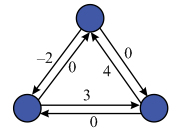
In the below graph, one new vertex, which is of orange color, is added into the above Graph G.
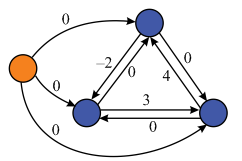
Next, assign the weight 0 to all the vertices which are connected with the new (source) vertex.
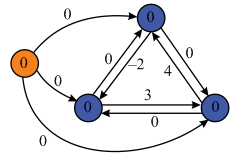
By using the Bellman-Ford algorithm, weights of vertices is calculated.

New non-negative weights of all the edges are calculated by using the weight function:










By using the reweighting technique, weights of edges can be calculated.
Thus from the above example, it is clear that weight
function always
contain positive value.
always
contain positive value.
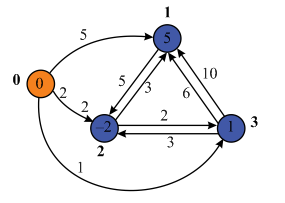
Using Johnson’s algorithm, weights of a directed and weighted graph can be rewritten without changing the shortest paths.
The flaw in the Professor Greenstreet claims:
Professor Greenstreet claims doesn’t guarantee that the shortest paths remain same, even after the graph is rewritten.
Counter example to Professor Greenstreet claims:
Consider the following graph with 4 edges and add minimum weight
(-10) to every weight to re calculate  .
.

The shortest path from  is
is  with weight
4 in the original graph.
with weight
4 in the original graph.
After rewriting the graph using Professor Greenstreet’s claim,
the shortest path from s to b, is changed. That is,
 with weight 15.
with weight 15.
Therefore, Professor Greenstreet’s claim changes shortest paths.
Consider a 0-weight cycle a-b-c in a directed graph
G. That is, Now, add a
new vertex s to the graph G such that there is
an edge between s to every vertex in the graph G.
Then, compute the new weights for each edge in the graph.
Now, add a
new vertex s to the graph G such that there is
an edge between s to every vertex in the graph G.
Then, compute the new weights for each edge in the graph.
Particularly,

Since the a-b-c is a 0-weight cycle, 
Hence,

Similarly,

Therefore, if any graph G has a 0-wieghted cycle, then the new weights of every edge in the cycle is 0.
Example:

Observe that the cycle 1-3-4, where w(1,3) + w(3,4)+w(4,1) = 0
Add the new vertex s and compute the new weights.
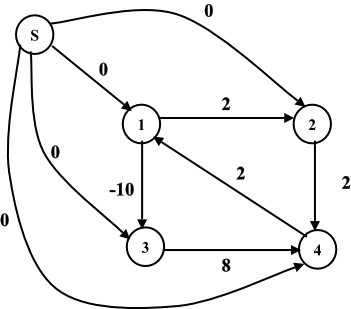
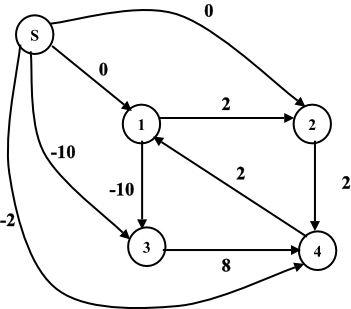
After rewriting the graph, the new weights are as follows:

Observe that,











